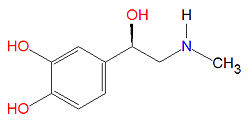Epinephrine: Difference between revisions
imported>David Finn m (adrenalin (no e) is a brand name) |
mNo edit summary |
||
| (One intermediate revision by one other user not shown) | |||
| Line 19: | Line 19: | ||
==Administration== | ==Administration== | ||
As the dose of epinephrine is sometimes expressed as a ratio only (1 mL of 1:1000) or a concentration only (1 mg in 1 mL), [[medical error]]s in administration may be made. <ref name="pmid18166759">{{cite journal |author=Wheeler DW, Carter JJ, Murray LJ, ''et al'' |title=The effect of drug concentration expression on epinephrine dosing errors: a randomized trial |journal=Ann. Intern. Med. |volume=148 |issue=1 |pages=11–4 |year=2008 |month=January |pmid=18166759 |doi= |url=http://www.annals.org/cgi/pmidlookup?view=long&pmid=18166759 |issn=}}</ref> | As the dose of epinephrine is sometimes expressed as a ratio only (1 mL of 1:1000) or a concentration only (1 mg in 1 mL), [[medical error]]s in administration may be made. <ref name="pmid18166759">{{cite journal |author=Wheeler DW, Carter JJ, Murray LJ, ''et al'' |title=The effect of drug concentration expression on epinephrine dosing errors: a randomized trial |journal=Ann. Intern. Med. |volume=148 |issue=1 |pages=11–4 |year=2008 |month=January |pmid=18166759 |doi= |url=http://www.annals.org/cgi/pmidlookup?view=long&pmid=18166759 |issn=}}</ref> This problem is compounded by the availability of 1:1000 and 1:10,000 concentrations for, respectively, subcutaneous and intramuscular, versus intravenous, use. | ||
===Subcutaneous and intramuscular administration=== | ===Subcutaneous and intramuscular administration=== | ||
Epinephrine is supplied as 1 mg/mL (1 mL, 30 mL) which is a 1:1000 solution. | Epinephrine is supplied as 1 mg/mL (1 mL, 30 mL) which is a 1:1000 solution. | ||
The dose for adults with [[immediate hypersensitivity]] reactions is 0.3-0.5 mg (0.3 to 0.5 ml) every 15-20 minutes. | The dose for adults with [[immediate hypersensitivity]] reactions is 0.3-0.5 mg (0.3 to 0.5 ml) every 15-20 minutes. Automatic injectors are available for self-administration by patients with known sensitivity. | ||
===Intravenous administration=== | ===Intravenous administration=== | ||
| Line 33: | Line 33: | ||
==References== | ==References== | ||
<references/> | <references/>[[Category:Suggestion Bot Tag]] | ||
Latest revision as of 06:00, 13 August 2024
|
| |||||||
| (-)-epinephrine | |||||||
| |||||||
| Uses: | natural hormone | ||||||
| Properties: | |||||||
| Hazards: | |||||||
| |||||||
Epinephrine (or adrenaline) is a sympathomimetic and catecholamine that is a "active sympathomimetic hormone from the adrenal medulla in most species. It stimulates both the alpha- and beta- adrenergic systems, causes systemic vasoconstriction and gastrointestinal relaxation, stimulates the heart, and dilates bronchi and cerebral vessels. It is used in asthma and cardiac failure and to delay absorption of local anesthetics."[1]
Administration
As the dose of epinephrine is sometimes expressed as a ratio only (1 mL of 1:1000) or a concentration only (1 mg in 1 mL), medical errors in administration may be made. [2] This problem is compounded by the availability of 1:1000 and 1:10,000 concentrations for, respectively, subcutaneous and intramuscular, versus intravenous, use.
Subcutaneous and intramuscular administration
Epinephrine is supplied as 1 mg/mL (1 mL, 30 mL) which is a 1:1000 solution. The dose for adults with immediate hypersensitivity reactions is 0.3-0.5 mg (0.3 to 0.5 ml) every 15-20 minutes. Automatic injectors are available for self-administration by patients with known sensitivity.
Intravenous administration
Epinephine is supplied as 0.1 mg/mL (10 mL) which is a 1:10,000 solution. The dose for adults during cardiac arrest is 1 mg every 3-5 minutes.
Uses
The uses of epinephrine include treatment of anaphylaxis, vasoconstrictor agent, and cardiotonic agent.
References
- ↑ Anonymous (2025), Epinephrine (English). Medical Subject Headings. U.S. National Library of Medicine.
- ↑ Wheeler DW, Carter JJ, Murray LJ, et al (January 2008). "The effect of drug concentration expression on epinephrine dosing errors: a randomized trial". Ann. Intern. Med. 148 (1): 11–4. PMID 18166759. [e]
